Women in politics: India
This is a collection of articles archived for the excellence of their content. |
Contents |
The status
1957- 2019
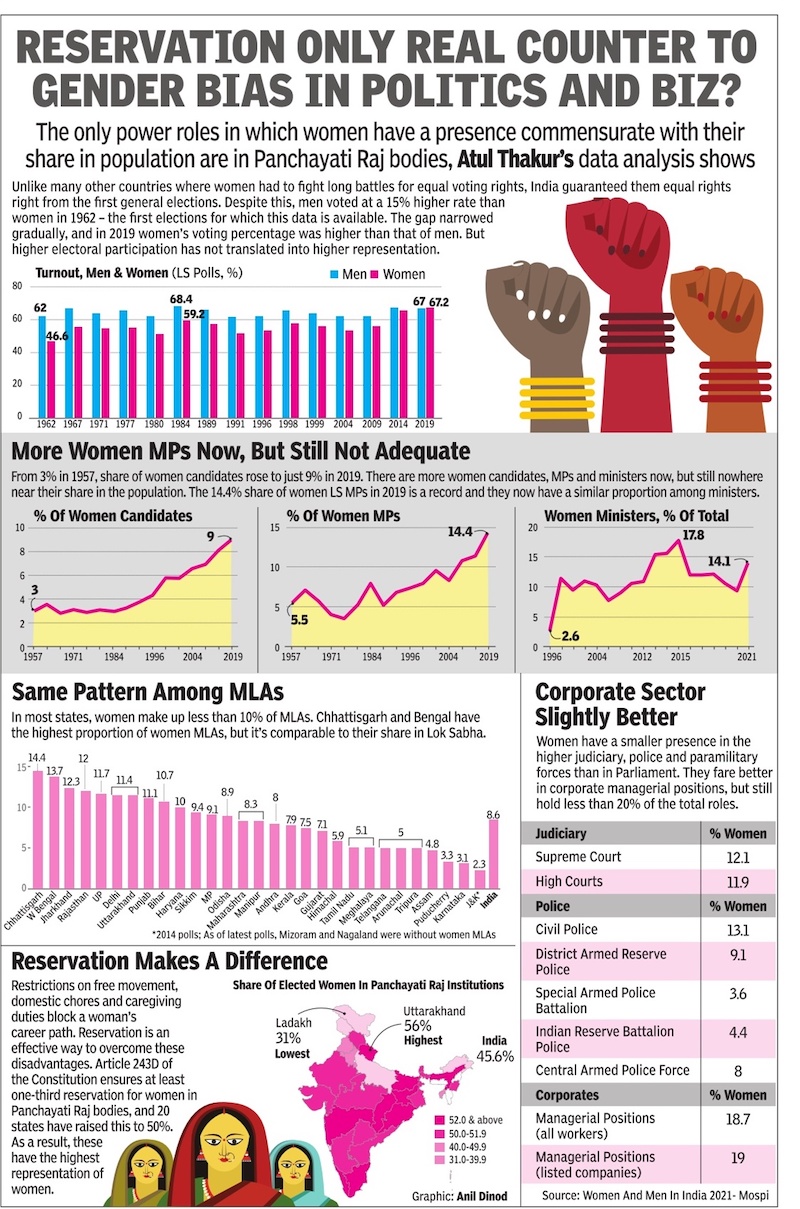
From: April 11, 2022: The Times of India
See graphic:
The status of Women in politics in India, 1957- 2019
Candidates
Women candidates, state-wise
April 8, 2024: The Times of India
Roughly half of all voters are now women. Yet, when it comes to candidates and MPs, women are only a very small part of the picture. In 1962 – the year from when continuous gender data is available for voters, candidates and MPs – 42% of the voters were women. By 2019, this had increased to 48.2% — almost equal to their share of population. But when it comes to candidates, only 9% were women. The count of MPs, though, was a little better at 14.4%, report Atul Thakur and Chethan Kumar.
Karnataka, along with Kerala, stands out as the worst state for aspiring women politicians, with only about 5 out of every 100 women candidates winning polls on average between 1996 and 2019. In contrast, Bengal emerged as the most hospitable state for women, with a winning rate of 20 out of 100 candidates. Gujarat emerged as the second-best state, followed by Rajasthan.
Elected representatives
1937, 1952
Adrija Roychowdhury, Sep 24, 2023: The Indian Express
Among the 499 seats in the first Lok Sabha, 22 were won by women. Though a small number, they argued eloquently, bringing in unique perspectives and introducing some of the most significant Bills in modern Indian history.
The women members of the India’s first Lok Sabha introduced Bills related to dowry, marriage, women and children’s institutions, divorce, food and health, which were of immediate concern to them. In the years to come, they would go on to bring forward Bills which were of wider national and international concerns.
It is worth noting that the issue of women’s reservation had traversed through complicated territory through the final years of colonial rule in India, when the British were still negotiating how much self-rule ought to be handed over to Indians. The British government under the 1935 Government of India Act had granted women 41 reserved seats in the provincial legislatures and limited reservation in central legislatures. Ironically, at that time, the policy was heavily criticised by women’s organisations themselves who saw the reservation as a way of dividing the nationalist movement and a violation of the “integrity of the universal demand of Indian women for absolute equality of political status”.
Despite the initial protests, the women’s groups did make the most of the new constitutional provisions. In the elections of 1937, as many as 80 women went on to become legislators. India at that time is known to have had the third highest number of women legislators after the United States and the Soviet Union. Political analyst Praveen Rai, in an article written for South Asia Research has noted that the limited experience with reserved seats in legislatures “gave women a foothold in Indian legislative life and set a precedent which women could draw on decades later”.
Independent India’s first government removed reservation for women in Parliament, retaining quotas only for Scheduled Castes and Scheduled Tribes. Nonetheless, in the first election of Independent India held in 1952, women went on to win and occupy 4.4 per cent of the seats in the Lok Sabha, many of them members of the Constituent Assembly that drafted the Constitution. Though a small number, the women MPs argued eloquently, bringing in unique perspectives and introducing some of the most significant Bills in modern Indian history.
Among the 499 seats in the first Lok Sabha, 22 were won by women. Most of them were elite, educated women. Rajkumari Amrit Kaur, Subhadra Joshi, Sucheta Kripalani, Ammu Swaminathan, and Annie Mascarene were among the prominent women members of the first Lok Sabha.
Rajkumari Amrit Kaur was appointed health minister and Maragatham Chandrasekar was appointed deputy minister for health.
A member of the Kapurthala princely family, Kaur was well known for being a staunch Gandhian, a zealous social reformer and also for the many contributions she made to the health infrastructure of the country. One of the first Bills she introduced as a member of the Lok Sabha was the Prevention of Food Adulteration that she presented in Parliament in August 1952, which became an Act in 1954.
Kaur’s most notable contribution though was the introduction of a Bill seeking to create a major central institute for post-graduate medical education and research. “It has been one of my cherished dreams that for post graduate study and for the maintenance of high standards of medical education in our country, we should have an institute of this nature which would enable our young men and women to have their post graduate education in their own country,” she had said, while presenting the Bill in Parliament on February 18, 1956. Kaur’s fervent speech sparked a vigorous debate in Parliament, but by May that year, the motion was adopted and soon after, the All India Institute of Medical Sciences (AIIMS) was born.
The dowry prohibition Bills were yet another important intervention made by women members of the Lok Sabha. It was introduced by Jayashree Raiji from Bombay Suburban constituency and Uma Nehru from Sitapur, Uttar Pradesh, in 1951, although it was first taken up for discussion only in August 1953, and enacted 10 years later in 1961.
Uma Nehru in her potent opening speech for the debate on the Bill had stated, “in terms of law, there have been no changes in the status of women, and whatever little changes have happened are merely superficial, as a result of which the condition of women even today is the same as what it was during the time of Manu.”
Maniben Patel, daughter of Vallabhbhai Patel, who represented Kheda in the Lok Sabha, introduced two important private Bills including the Suppression of Immoral Traffic and Brothels and the Women’s and Children’s Institutions (Licensing). Patel along with other women members such as Uma Nehru and Seeta Parmanand had argued that a large number of bogus children’s houses and orphanages are existing in the country and exploiting destitute women, and therefore, it was necessary to regulate and license such institutions. After undergoing several rounds of debates, the Bill was enacted in 1956.
Several of the Bills introduced by women members of the first Lok Sabha would appear to be way ahead of their time. Renu Chakravarty from Basirhat, West Bengal, for instance, introduced the Bill seeking equal pay for equal work for women workers in 1956. In her statement, she reasoned, “such provision exists in certain advanced countries. The principle is embodied in the Indian Constitution”. She also cited the International Labour Organisation that recommended the acceptance of equal pay for equal work by member countries.
Also worth noting is the way women members debated against Bills introduced by the male members, bringing in a point of view that would otherwise be missing. In July 1952, for instance, Fulsinhji Bharatsinhji Dabhi had introduced a Bill seeking the amendment of a section dealing with adultery in the Indian Penal Code. Dabhi had reasoned that the clause which made only men punishable for adultery must be amended to make women equally responsible. Responding to his arguments, Jaishree Raiji had delivered a powerful speech stating that women were far from being equal to men in Indian society and that before bringing in such a law, it is necessary for society to first do justice to women.
“I think that first of all, our society is not yet ready to follow the Constitution which lays down that there should be no discrimination. At present, women are considered merely as a piece of weak, helpless piece of human flesh, devoid of soul… First we should see that she gets economic independence and then we should try to change the law,” she argued.
The Workmen’s Compensation Bill in 1955, The Factories (Amendment) Bill, the Indian Adoption of Children Bill, the Hindu Marriage (Amendment) Bill were some of the other significant interventions made by women members of the first Lok Sabha that went on to make way for some far-reaching structural changes in Indian society.
1954-2014: Women who won
March 13, 2019: The Times of India
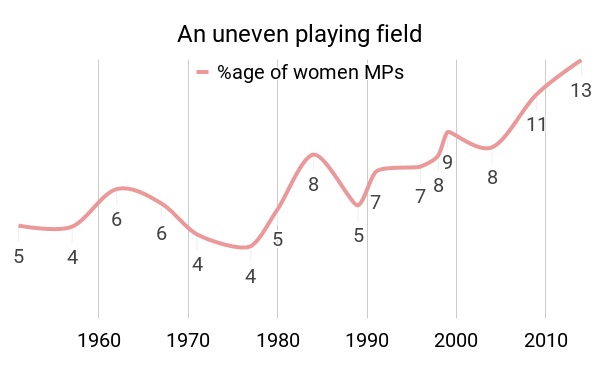
From: March 13, 2019: The Times of India
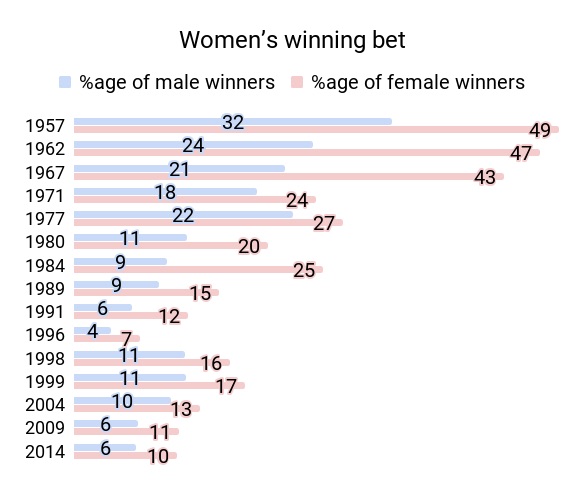
From: March 13, 2019: The Times of India
Dismal record: For a country whose constitution espouses gender equality, the proportion of female lawmakers in the lower house of the parliament has oscillated between a nadir of 3.50% in 1977 to a peak — or rather a mud mound — of 12.52% in the 16th, or the outgoing Lok Sabha. In fact, the last two parliamentary elections — for the 15th and the 16th Lok Sabha in 2009 and 2014 respectively — have seen the share of elected women MPs increase to over 10% of the parliament’s total strength of 543 members.
Winnable women: Women candidates have a constantly higher success ratio at the hustings than their male counterparts, with a greater proportion of women winning from among the total number of women contesting the elections, vis-a-vis their male peers. However, that could also be because of a fewer number of women candidates contesting polls — as the number of women candidates rise, their success ratio has also started decreasing from a peak of almost 49%, or nearly half of them, winning in 1957 to 10% in 2014.
The male skew: That parties still prefer male candidates to female candidates — unless they are confident of ‘her’ victory in a constituency — may be gauged from the fact that in the last election alone, in 2014, there were over 7,500 male candidates in the fray. This was almost twice the number of all the female candidates who have ever contested in Lok Sabha elections since the first parliamentary elections in 1951. (Un)fair enough!
2011, 2016 Assembly elections in 4 states
The Times of India, May 09 2016
Only 9% of women netas won in 4 state polls in 2011
While the number of women contestants has more or less stagnated in West Bengal, Assam and Kerala, in Tamil Nadu the number of women contestants has nearly doubled from 6% to 11% since 2011 assembly polls.
Though Bengal has a woman chief minister, only 10% of the tickets went to women in 2016. In Kerala, the number was even less, at 8%. Both states had the same percentage of women candidates in the 2011 polls. Assam improved its tally marginally , with the percentage of women candidates rising from 8% to 9%. The percentage of women winners in the four poll bound states was depressingly low in 2011. In the 2011state polls, the percentage of women who won was about 9%, according to National Election Watch. In Bengal, women won 33 of 285 seats (12%), while in Assam it was only 11% (14 of 126 seats). In TN, the percentage was even lower at 7% (16 of 225 seats) and in Kerala women won only 6% (7 of the 126 seats).
This news comes at a time when parties have acknowledged and are actively wooing the woman voter. This was first seen in the 2014 general elections when the percentage of women voters rose to 65.6% from 55.8% in 2009. The total voter turnout was 66.4%, up from 58.2% in previous polls.
The influence of women voters is reflected in the sops promised by parties, whether it is prohibition, maternity benefits or pension schemes.Tamil Nadu CM Jayalalithaa recently promised to increase financial assistance under a maternity scheme from Rs 12,000 to Rs 18,000, assured to double the quantum of gold for `tali' (mangal sutra), provide subsidy for women to buy scooters and train them to drive. In Bengal, Mamata Banerjee has promised a pension scheme for women and increase in the number of female police personnel.
In several states, women outnumber male voters. According to a report, states like Bihar, Rajasthan, Punjab, Odisha, Tamil Nadu and Uttarakhand have a burgeoning female population.
Women legislators in the Indian states: 2017
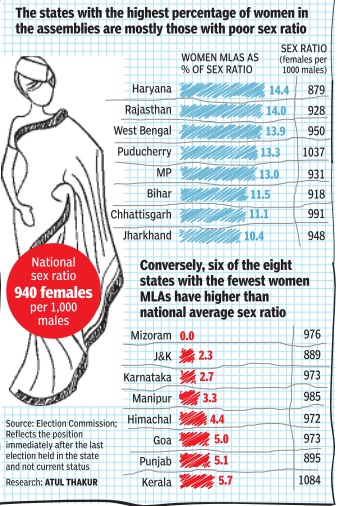
See graphic, 'Women legislators in the Indian states, 2017'
2017: candidates and voters
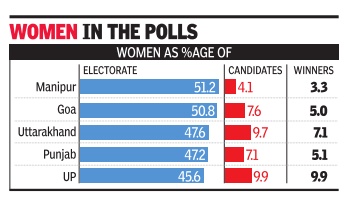
See graphic:
Women candidates and voters as a percentage of the total in the state assembly elections of 2017
Parties that field women the most
1996-2014
Chethan Kumar, Cong best in fielding women, BSP worst, March 14, 2019: The Times of India
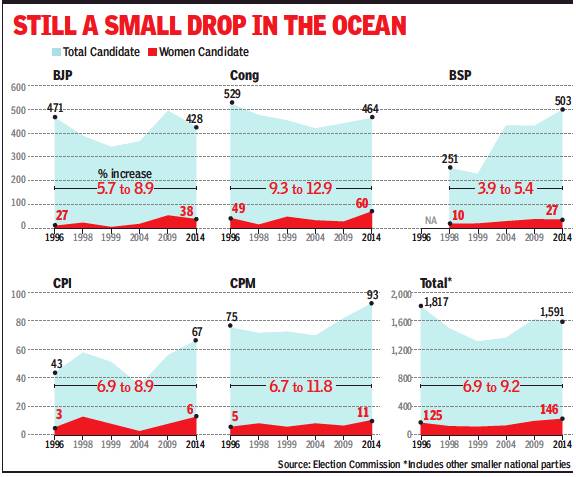
From: Chethan Kumar, Cong best in fielding women, BSP worst, March 14, 2019: The Times of India
13% Of Poll Tickets Is The Most They’ve Got
Mamata Banerjee’s Trinamool Congress has given 40% of its election tickets to women while Naveen Patnaik’s Biju Janata Dal has decided to set aside 33%, but most national political parties don’t walk the talk on women’s representation in Parliament.
It’s still early to say how many women each party will field this time but data from the past six Lok Sabha elections reflects a political unwillingness that is spread across the top five national parties — BJP, Congress, CPI, CPM and BSP.
An analysis of Lok Sabha elections from 1996 to 2014 shows none of them has given more than 10% of their tickets (all elections taken together) to women. In individual elections, some have exceeded the 10% mark. But no one is close to the 33% reservation in the Lok Sabha that women have been demanding for a long time.
Congress fielded the maximum number of women, both in terms of the absolute number and as a percentage of the total number of candidates the party gave tickets to. Mayawati-led BSP fielded the least number of women. Overall, the five national parties together fielded 9,174 candidates in six elections, of whom only 726 (8%) were women.
As for state parties, they fielded 252 women candidates in the six Lok Sabha elections combined. The number of women who got tickets from unrecognised parties and the number of independents was 649 and 1,109, respectively.
Ritu Singh, a former BSP member now with BJP, says, “There is a problem across parties, and as somebody who speaks on behalf of BJP as its spokesperson, I think women must get 50% of the tickets. In BSP, Behenji (Mayawati) herself did not do this. I have had several talks with her, but women never got the kind of importance in that party. Maybe, she was scared.”
On an average, Congress gave 1 in 10 tickets to women, while BSP had only 5% of its candidates as women. BJP and CPI each gave 8% of their tickets to women and CPM gave 9%. Of the 2,780 candidates that contested on Congress tickets in these elections, 286 were women. BSP gave tickets to 96 women among its 1,847 candidates, and BJP fielded 196 women in its pool of 2,490 candidates.
BSP spokesperson Ashok Siddharth says, “Where is the question of more tickets to women or less when our national leader herself is a woman? We are giving tickets to women everywhere, in Uttar Pradesh, Haryana, Madhya Pradesh, Rajasthan, Chhattisgarh and everywhere. You are comparing BSP with BJP and Congress. We are not just a political party but a movement.”
Election-wise analysis shows Congress has, in two elections, handed 11% of its tickets to women and it touched 13% in 2014. BJP and Mayawati-led BSP have never crossed 10%, while CPM crossed 10% at least twice in six elections.
Congress spokesperson Priyanka Chaturvedi, while conceding that women need better representation across the parties, says, “Women do not get a free hand, and the leadership often does not show confidence. The Congress was committed to 33% reservations for women and we know that the battle won’t end there.”
Representation in the parliament, State Assemblies
1951 – 2021
Sep 20, 2023: The Times of India
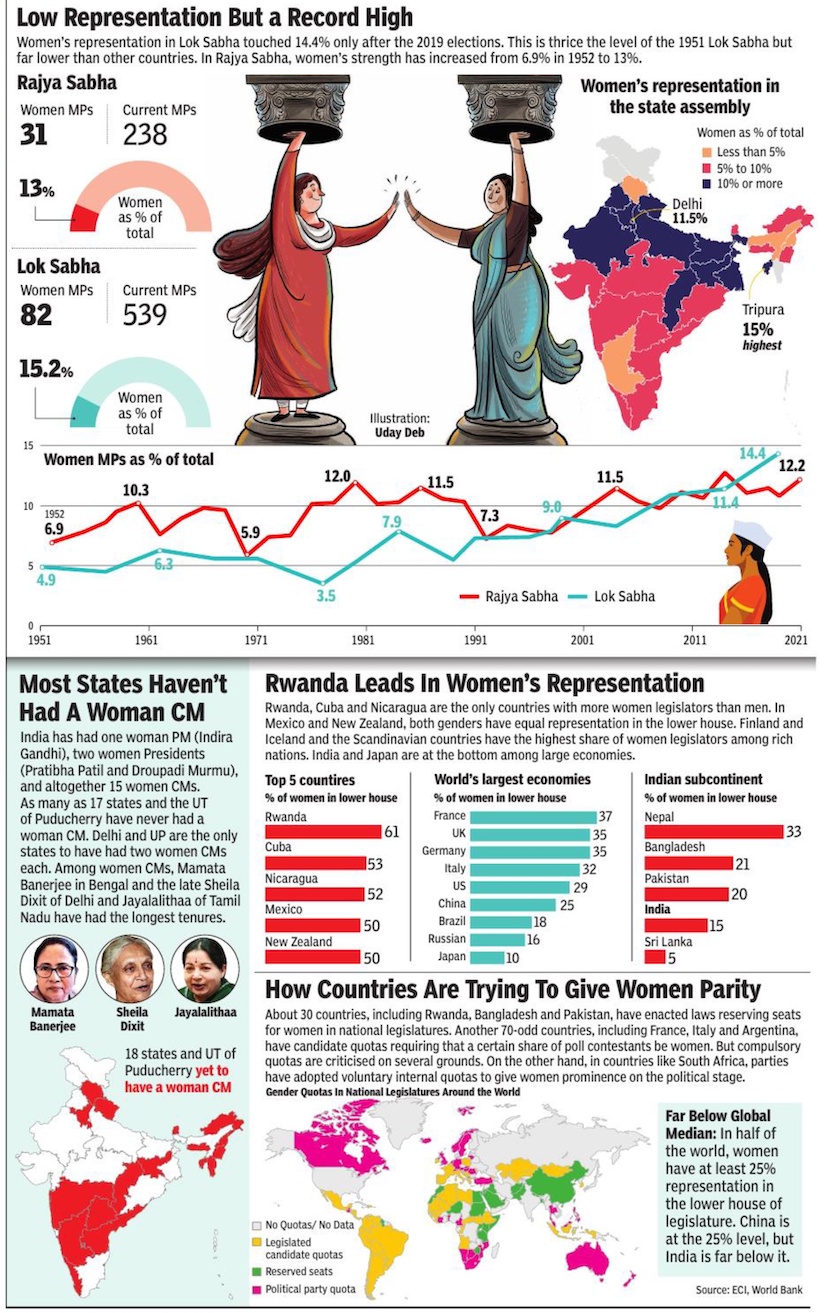
From: Sep 20, 2023: The Times of India
See graphic:
The Representation if women in the Indian parliament, State Assemblies, 1951 – 2021
There are 82 women MPs in the Lok Sabha (15.2%) and 31 in the Rajya Sabha (13%). Barring Tripura, states have even lower women’s representation in their assemblies. Women make up 10% or more of legislators in only 11 states while Mizoram doesn’t have a single woman MLA. Atul Thakur breaks it down
States that field women the most
1996-2014
Chethan Kumar, Their chances highest in Bengal, lowest in K’taka, March 14, 2019: The Times of India
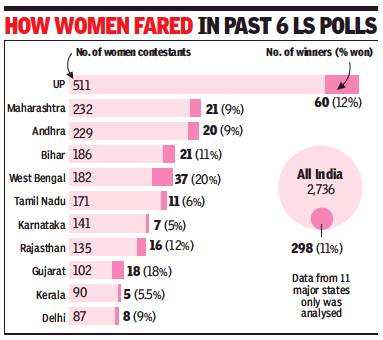
From: Chethan Kumar, Their chances highest in Bengal, lowest in K’taka, March 14, 2019: The Times of India
Trinamool Congress’s decision to give 40% of its election tickets to women is as much about strong political maths as it is about poll symbolism. An analysis of the past six Lok Sabha polls shows that Bengal is the best bet among India’s major states for a woman to get elected into Parliament.
The worst? Karnataka. In Karnataka, if women contested 100 seats, they would win in five, compared to 20 out of 100 in Bengal. Among the other nine major states — Gujarat, Rajasthan, Tamil Nadu, Kerala, Andhra Pradesh, Bihar, New Delhi, UP and Maharashtra — winnability of women candidates is the best in Gujarat (18 out of 100), followed by UP (12) and Bihar (11).
“Political parties need to effectively ensure that the participation of women increases by showing confidence in them. Unfortunately, a woman’s entry into politics is fraught with difficulties — from having to prove their credibility to showing they are capable of dealing with the system,” says Priyanka Chaturvedi, national spokesperson for Congress.
Overall, 2,736 women contested in the past six LS elections, of whom only 298 (11%) won. Among the losers, more than 76% (2,090 candidates) lost their deposit. In Karnataka, just seven women won of the 141 who contested these polls while 119 of them forfeited deposits and 15 secured their deposits but still lost.
MK Kanimozhi of DMK says, “Women in political parties are still expected to be under the control of men, which prevents many women from even entering politics. It is not enough that the leadership decides to give more tickets. The candidate would require support at the ground level to win. Unfortunately that is not happening, which is a reflection of how our society views women.”
Voters and candidates
1952 – 2019
Atul Thakur & Chethan Kumar, April 8, 2024: The Times of India

From: Atul Thakur & Chethan Kumar, April 8, 2024: The Times of India

From: Atul Thakur & Chethan Kumar, April 8, 2024: The Times of India

From: Atul Thakur & Chethan Kumar, April 8, 2024: The Times of India
India’s first election was among the world’s most challenging administrative tasks of the 1950s. Its unprecedented scale and prevailing social conditions — less than 20% literacy, for one — created many problems. It might surprise you that the names of about 2.8 million women, mostly in the Hindi belt, were struck off the electoral rolls because they wanted to be identified by their relation to men: A’s mother, B’s wife, C’s daughter, etc. Over the years, Indian women’s participation in elections as voters and representatives has increased but the progress is so slow that India remains far behind most major countries.
Seen as voters, not candidates
Continuous gender data is available for voters, candidates and MPs from 1962. While the number of women voters has steadily increased, their proportion as candidates and MPs has grown at snail’s pace.
With the efforts of Election Commission and parties, the share of women voters rose from 42% in 1962 to 48.2% in 2019, roughly equal to their share in the population. But women’s share among candidates only increased from 3.2% to 9% in the same period, and they made up 14% of MPs in 2019 – far lower than the 33% stipulated reservation for them.
Most parties stingy with tickets
Over the seven elections from 1996 to 2019, none of the top national parties gave more than 10% of their tickets to women even though the HD Deve Gowda-led United Front govt had introduced a Constitution Amendment Bill for reservation in Parliament in Sept 1996. Some parties did give more than 10% tickets to women in some elections. On average, Congress gives at least 1 in 10 tickets to women, while BSP gives only 1 in 20. BJP and CPI give 8% each, and CPM 9%. Taken together, women average 8.5% of these five parties’ candidates.
Women decide results, even in Hindi belt
Just 15 years ago, in 2009, women made up less than 45% of voters in the states of Madhya Pradesh, Jharkhand, Bihar, Uttar Pradesh and Rajasthan. These states have witnessed the highest increase in the share of women voters to catch up with the rest of the country.
More women than men vote in 11 states
Women make up almost half of the voters in most states, barring a few like Delhi, Haryana, Maharashtra and Gujarat that men migrate to for work. In 11 states and UTs, led by Puducherry (52.2%), women outnumber men as voters. Mizoram, Meghalaya and Manipur follow. Among larger states, Chhattisgarh, Telangana, Kerala and Tamil Nadu also have more women voters.
Women make up al Women MLAs also a small set
Women are an important constituency that all parties woo with special schemes, such as free bus rides and direct money transfers, but they don’t get many tickets even in state elections. In fact, all states with the exception of Chhattisgarh and Tripura have a smaller proportion of MLAs than parliamentarians.
Advocate and former Karnataka MLA Pramila Nesargi had earlier told TOI that men only want to see women as primary school teachers, nurses and air hostesses but not MLAs. “Until there’s reservation, no major party will field women,” she had said.
What’s driving the revolution?
Women voters have steadily increased during the past few elections, both in absolute numbers and as a percentage. What’s responsible? TOI talked to a few experts. Tara Krishnaswamy, who started Political Shakti to advocate for higher representation of women in politics, says the number of women voters has gone up because both population and education levels have increased. This means women are finally comfortable putting down their own names, rather than being referred to as someone’s wife or mother.
Political parties have also played a big role in raising awareness. “It was in their (parties’) interest to woo women and bring them out to vote, as it meant an incremental increase in votes,” she says.
“Political parties have been a catalyst for change by pursuing the women’s vote and creating women-centric policy interventions, such as sops linked to women’s education and livelihoods,” Krishnaswamy says. Kanksshi Agarwal, founder of NETRI Foundation, an incubator and aggregator for women in politics, says mobilisation of women became a core focus area when parties could no longer be assured of the male vote. “Men would migrate to work, and travelling back home to vote came at the expense of time and cost,” she says.
The EC also did its bit. It created enabling conditions to make it more comfortable for women to visit booths and vote without being pushed and shoved by strange men, she says. There were special provisions made for pregnant women and seniors, too.
Agarwal stresses capacity-building. NETRI conducts training workshops for women not just to vote but as campaigners and public leaders. “Politics must be seen as a job. Just as you would train for a job, you need to train as a politician,” she says.
So, what would be the ideal scenario? Instead of a “women’s wing” in parties — which remains peripheral to decision-making — there should be a gender cell in every department of the party to examine each issue through the gender lens, whether it is poverty alleviation or climate change, Agarwal says.
— Himanshi Dhawan
18 states have never had a woman CM
Only 13 of 31 assemblies in the country have had a female CM, while UP, Delhi and Tamil Nadu have had two each (not counting multiple terms of same CM)
Much catching-up to do
Countries with higher Human Development Index rankings tend to have higher women’s representation. New Zealand, for instance, has more than 50% women MPs. Spain, France, Germany, UK and Italy also have more than 30% women legislators each in the lower House. India lags not only these wealthy countries but also Nepal, Bangladesh and Pakistan in its neighbourhood.
Women in municipal corporations
Delhi
March 16, 2013: The Times of India
Civic seats fail to empower
The three municipal corporations in Delhi now have half of the seats reserved for women. The move to empower women got 156 councillors into the Houses in the 2012 elections against 90 women councillors in 2007. However, it turns out that increasing the number doesn’t mean their male counterparts would accept them as equals.
During a heated discussion on the inauguration of a road under-bridge on January 21, a male councillor of North Delhi Municipal Corporation had threatened and thrown empty water bottles at women councillors in the front row to hush them. The women councillors complained to lieutenant governor Tejendra Khanna and it was decided that 10 marshals would be deployed during meetings for their safety. However, nothing has been done so far.
The same corporations also have less than 20% women staff at the senior level while it has close to 60 such posts. Around 10-12 women head various departments, but there is only one woman additional commissioner in all three corporations. They comprise 35-40% of the total workforce.
The erstwhile MCD was never headed by a woman. Now, all three mayors are women. But this is due to reservation.
New Delhi Municipal Council has a woman, Archna Arora, as its chairperson but there aren’t many women directors. Of the 20 departments, women are heading just three while women comprise around 30% of the total workforce.
Women voters
Outnumbering men/ 2019

From: March 14, 2019: The Times of India
See graphic:
In 8 states Women voters Outnumbered men in 2019
See also
Women in senior corporate positions: India